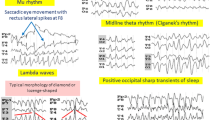Abstract
The history of discovery of the presence of an electrical signal accompanying the beat of the heart is traced from the mid 1800s, when there were no electrical recording instruments to the modern ECG. The saga is one of the use of brain power to overcome the lack of technology and illustrates the psychological difficulty in accepting new ideas.
Similar content being viewed by others
REFERENCES
Ader J. Sur un nouvel appariel enregistreur pour cables sous-marins. C R Acad Sci 124: 1440–1444, 1897.
Burch GJ. On a method of determining rapid variations of potential by means of the capillary electrometer. Proc R Soc London 48: 89–93, 1890. Communicated by J. Burdon-Sanderson.
Burdon-Sanderson J and Page FJM. On the time-relations of the excitatory process in the ventricle of the heart of the frog. J Physiol 80(2): 384, 1879.
Burdon-Sanderson J and Page FJM. On the electrical phenomena of the excitatory process in the heart of the frog and of the tortoise as investigated photographically. J Physiol London 4: 327–338, 1883.
Deprez M and d'Arsonval A. Galvanometre apercodique. C R Acad Sci 94: 1347–1350, 1882.
Einthoven W. Ueber die Form des menschlichen Electrocardiogramms. Pflugers Arch 60: 101–123, 1895.
Einthoven W. Un noveau galvanometer. Arch Neerl Sci 6: 625–663, 1901.
Einthoven W. Die galvanometrische Registrirung des menschlichen Elektrodardiogramms, zugleich eine Beurtheilung der Anwendung des Capillar-Elektrometers in der Phsiologie. Pflugers Arch IV 99: 472–480, 1903.
Einthoven W. Le telecardiogram. Arch Int Physiol 4: 132–164, 1906.
Geddes LA and Wald A. Horatio B. Williams and the first electrocardiographs made in the United States. IEEE EMBS magazine. 2000 Sept./Oct. 117–121.
Haynes JR. A heated stylus for use with waxed recording paper. Science 7: 108, 1936.
Koelliker RA and Mueller J. Nachweis der negativen Schwankung des Muskelstroms am naturlich sich contrahirenden Muskel. Verh Phys Med Ges Wurzburg 6: 528–533, 1856.
Mann H. A light weight portable EKG. Am Heart J 7: 796, 1930/31.
Marey EJ. Des variations electriques des muscles du coeur en parriculier etudiee au moyen de l'electrometre de M. Lippmann.CR82: 975–977, 1876.
Marvin HB and Leibing JK. Electrical indicating instrument. US patient 1,837,913 filed, Jan. 15, 1925.
Waller AD. Denonstration on man of electromotive changes accompanying the heart beat of man. J Physiol London 8: 229, 1887; and 180B: 169–194, 1887.
Waller AD. Physiology, The Servant of Medicine, Hitchcock Lectures. London: University of London Press, 1910.
Author information
Authors and Affiliations
Rights and permissions
About this article
Cite this article
Geddes, L.A., Roeder, R.A. The First Electronic Electrocardiograph. Cardiovascular Engineering 2, 73–79 (2002). https://doi.org/10.1023/A:1020933420192
Issue Date:
DOI: https://doi.org/10.1023/A:1020933420192




